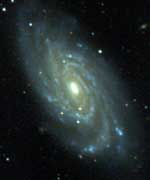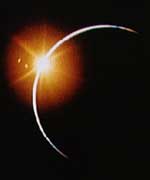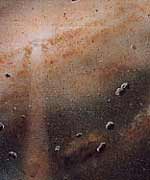
Image credit: SDSS
Listen to the interview: Alpha, Still Constant After All These Years (3.3 MB)
Or subscribe to the Podcast: universetoday.com/audio.xml
Fraser Cain: Can you give me the primer on Alpha?
Jeffery Newman: So Alpha is one of the constants that describes the strength of a fundamental force; there are 4 fundamental forces: electromagnetism, the weak force, the strong force and gravity and Alpha basically determines the strength of the electromagnetic force compared to the other 4. As such, it’s a very basic part of the quantum theory of how these forces work and how they scale with energy (and) how they scale with time in the universe.
Fraser: What in the universe depends on it; how would the universe be different if Alpha was different?
Newman: Because Alpha determines how strong the electromagnetic force is; that’s the force that holds atoms together; that’s the force that causes things to interact with light, so if the force (Alpha) had different strength, atoms wouldn’t hold together, as well or they might hold together too strongly to allow chemical interactions. As well, if light and atoms didn’t interact very well, it would be very hard to see for instance, as we do. It is essential to our life. Because it’s so fundamental, it has ramifications all over the place that you wouldn’t even expect that can have affects on almost every interaction an atom undergoes or how an atom is structured.
Fraser: Where did the prediction come from that Alpha should remain constant since the Big Bang? Why was this even open to speculation?
Newman: It was generally expected that it was a universal constant of the universe. There were predictions in fact, that it was not just a constant, but a very simple constant that would be an integer; whatever 136 or whatever 137. For a while it was thought to be the value; not a 137.1, but a 137 even. That turned out to be numerology; it didn’t hold true, but it’s a value that comes out of nowhere, but is a fundamental part of the standard model of particle physics and all the other standard values of particle physics are things like the mass of an electron, the very basic thing. We would expect that there would be numbers that would describe the universe as a whole and if they describe the universe as a whole, they should describe they should describe it at any time or any place. Only in the last 20 or so years, when there have been unification theories, that predict many extra dimensions; there are theories that also predict that the constants of the universe as we perceive them are influenced by the presence of these extra dimensions and over time or over space, the values of these constants could actually change because of the extra degrees of freedom provided by these dimensions. Dark energy theories today also can predict changes in Alpha over time.
Fraser: Now I had reported a week before your story had come out that some Australian researchers had found that Alpha had been changing which I guess was a pretty big announcement. Do you know what research they had done to determine that it had changed?
Newman: So they’re using ? again an astrophysical method; trying to look at observations of very distant objects, deep in the past; in the distant universe, and tried to use those observations to look at quantities that should depend on Alpha; in their case, they’re looking at the wavelengths of light that are absorbed by gasses between us and quasars that are very bright objects, very far away. They have a method that tried to use many different kinds of elements counterbalancing each other trying to get as much sensitivity to Alpha as possible, but because it’s a complicated method, it requires a lot of complicated calculations. It’s certainly a more complicated method than the one we’ve tried. We’ve tried to keep things simple. So there are actually some groups who have used the same method and some of them have found changes in Alpha and some of them have found no change in Alpha with the method the Australian group is using.
Fraser: What was the method that you had used?
Newman: We are looking, not at quasars, not at the very brightest objects, but rather at galaxies which are more abundant. So we can look at greater numbers of objects. And it turns out that we are looking at a particular simple set of measurements, set of wavelengths; transitions in atoms that we can use to measure Alpha. It depends in a very straightforward way on the value of Alpha over time, so by making a pretty simple measurement, we were able to set a constraint on how Alpha could evolve without having to worry about lots of atomic physics and nuclear physics, but just the simplest thing we can do. Alpha is called the Fine Structure Constant, and we were actually measuring the strength of a Fine Structure transition in oxygen atoms.
Fraser: How precise is the calculations that you’re coming up with?
Newman: The precision is mostly limited by the just the number of objects we have in the DEEPTWO Redshift Survey; the dataset we’ve used to do this. Now, out of 50,000 objects in the survey, we have about 500 we can use for this test. That gives us a precision of about a part in 30,000 on the value of Alpha.
Fraser: Because I recall the Australians, it (Alpha) had changed in 1 in 100,000 or something like that?
Newman: Yes, so we can’t yet rule out their measurement. It’s modestly discrepant at this point. No scientist would look at these values and say one rules out the other because their nominal precision is high. The question is could there be something systematically wrong with the measurement; could there be something that goes wrong with that technique? Given that different groups have gotten different values it’s likely that something is wrong with one of the groups or the other; either the group that defines a change in Alpha or the group that doesn’t. We can’t yet rule that out, but with a larger sample, using our simple method, we can make a determination.
Fraser: What would it take then for you to be able to come to a conclusive answer that both you; the changers and the static people come to an agreement?
Newman: I think that more data coming from us would certainly help because currently we are able to show that we are not limited by any sort of systematic error or systematic uncertainty in what we’re doing. We are limited just by random errors and random errors, you can make better if you have a larger sample. The other techniques, the other groups are also trying to get more data to reduce their errors and to try to do measurements of a couple of different types to see if they can get consistent answers, not just with this more complex version of the method of looking at quasars, but now they are taking a step back and trying to use a slightly simpler method of that as well. So, hopefully these will converge and try to come to a common answer once their data sets come in.
Fraser: Right. Let’s say that you are wrong and it (Alpha) has been changing over time, what could that mean for the future of the universe? If it keeps going.
Newman: So the changes that are found are relatively slow; even the groups that do find significant changes and the changes that are found would be expected to get slower and slower as time goes on. Most predictions are that if Alpha does change, that it’s mostly changing in the first seconds of the universe. It just gets slower and slower and slower after that. So a secondary effect in the end, if it’s very slowly changing, the stars will burn out before it changes enough to affect the chemistry and interactions of atoms.



